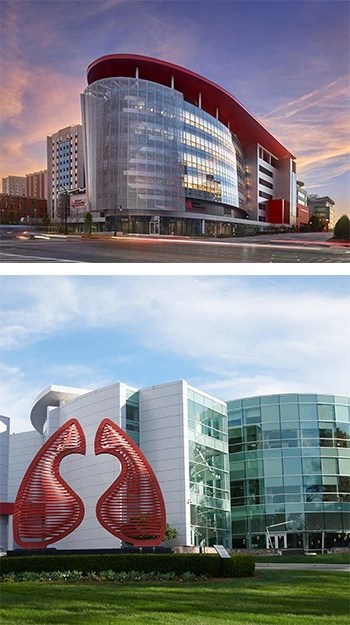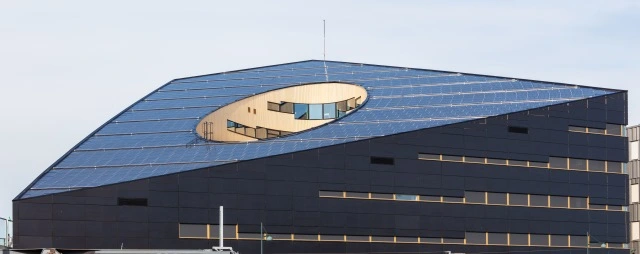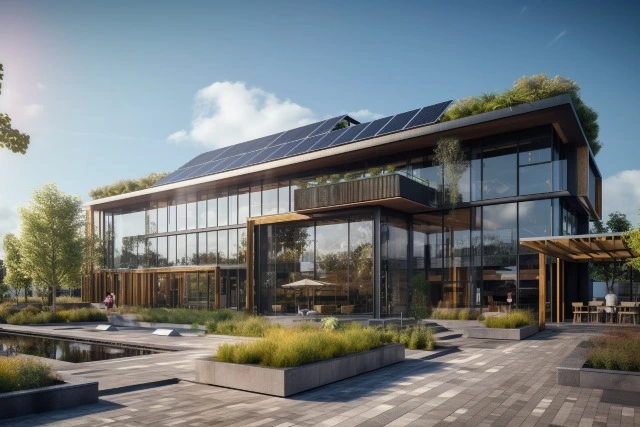Climate concerns are no longer waiting at our doorstep; they have crossed the threshold and demand immediate action. The commercial real estate industry is responding to these concerns with a push for net zero energy buildings and green construction, paving the path towards a sustainable future.
What classifies as a net zero energy building?
A net zero energy (NZE) building, as the name suggests, is a structure that produces as much energy as it consumes over a year. This balance in consumption and production is achieved through a combination of energy-efficient design, technologies, and renewable energy sources. They often incorporate aspects of autonomous buildings to reach net zero energy.
Key technologies and design principles
Creating a NZE building involves combining state-of-the-art technologies and strategic design principles. Key elements include:
- Energy-efficient appliances include high-efficiency HVAC (heating, ventilation, and air conditioning) systems and Energy Star-rated products, which significantly lower a building’s energy consumption.
- High-quality insulation: Used in walls, roofs, and floors to minimize heat loss, high-quality insulation reduces the need for artificial heating or cooling.
- Smart lighting systems use sensors and automated controls to adjust lighting based on occupancy and daylight availability.
- Passive solar design: This design principle involves positioning windows, walls, and floors to maximize the use of natural sunlight for heating and lighting.
- Optimal building orientation: A strategically oriented building minimizes exposure to hot summer sun and maximizes exposure to winter sun.
- Renewable energy systems: Solar panels, wind turbines, and geothermal systems are standard installations in NZE buildings to generate electricity.
- Energy recovery ventilation: These systems recover energy from exhaust air, reducing the energy load on the HVAC system.
- Smart metering and energy management: These technologies provide real-time data on energy consumption patterns to identify opportunities for further energy savings.
Is net zero a realistic target?
Achieving NZE is increasingly realistic, driven by technological advancements, supportive policies, and growing public awareness. Technological progress has improved the efficiency and lowered the cost of solar panels, wind turbines, and energy-efficient appliances.
Meanwhile, government incentives promote NZE construction, and the public’s rising awareness of climate change creates demand for energy-efficient buildings. Together, these factors are making NZE an achievable and economically viable goal.
Leading examples of net zero energy buildings around the world
To demonstrate the practical application and potential of sustainable architecture, these green buildings from different corners of the world highlight the global momentum toward net zero energy solutions.
USA: A prime example of a zero-energy building is The Unisphere in Maryland. Harnessing the power of over 3,000 solar panels, a geo-exchange system, and a microgrid, this 210,000-square-foot complex is one of the largest commercial structures of its kind in the United States. It stands out for its innovative approach to sustainable construction, including features like rainwater collection.

Photo upper: Co-Headquarters and Laboratory Complex, Silver Spring, MD. Photo lower: Co-Headquarters, Research Triangle Park, NC.
Norway: Located in Trondheim and completed in 2019, Powerhouse Brattørkaia is among the most notable new energy-positive buildings in Europe. It’s designed to produce more energy over its lifetime than it will use, including construction and demolition energy. It uses solar panels and a seawater heat pump, in addition to an energy-efficient design, to achieve this.

Photo: Diego Delso, delso.photo, License CC-BY-SA
Japan: An exemplary model of a net zero energy community is the SMA x ECO town Harumidai in Osaka. Designed as a sustainable residential area, it integrates solar power generation, energy storage, and energy management systems. With a focus on state-of-the-art technologies and initiatives like shared energy resources, SMA x ECO town Harumidai stands as a fine example of what’s achievable in the realm of NZE development on a larger scale.

Photo: SMA Eco Town Harumidai
The environmental impact of zero-energy buildings
The impact of NZEBs and green construction extends beyond the structures themselves by helping to combat climate concerns and create healthier communities.
Reducing carbon footprints and conserving resources
Net zero energy buildings are great for reducing carbon footprints. Since they make as much energy as they use, their carbon accounting balances out on a year-by-year basis. Plus, green construction uses recycled and eco-friendly materials, which helps conserve resources.
The role of renewable energy sources
Renewable energy is a big part of the zero-energy building concept. Renewable technologies such as solar panels, wind turbines, and geothermal power systems create the energy the building needs. This means less reliance on traditional power grids and more use of clean, renewable energy sources.
Benefits for the surrounding ecosystem
Net zero energy buildings can even help the local ecosystem. Green roofs and walls can become homes for local wildlife, and sustainable water management systems can help conserve local water resources. Fewer emissions also help improve local air quality, resulting in a healthier community.
What investing in net zero energy construction can bring you
Choosing to go with NZE construction isn’t just good for the environment. It also results in more efficient buildings with higher property values.
Long-term cost savings and energy efficiency
Although investing in a net zero energy building involves higher upfront costs, it offers significant financial benefits in the long run. The self-sufficiency of NZE buildings leads to substantial savings on energy bills over time. You can use a commercial energy audit to estimate the savings of zero-energy investments.
Often, they also produce excess energy. This extra energy can be sold back to the grid, providing an additional income stream. Over time, these savings and earnings can offset the initial investment in NZE technology, making it a financially sound choice in the long term.
Enhancing property value and appeal
Net zero energy construction can significantly increase property value. As energy costs rise and environmental consciousness grows, more people seek energy-efficient homes and offices. Properties that promise energy efficiency, lower operating costs, and reduced environmental impact have a competitive edge in the market.
In line with the green movement in CRE, policy trends are shifting towards mandatory energy efficiency standards in many regions. Buildings that already meet these standards are likely to appreciate, making NZE construction an intelligent investment for the future.
Preparing for a sustainable future in commercial real estate
The journey towards a net zero energy future in commercial real estate relies heavily on technology. Proptech solutions aid in enhancing energy efficiency, reducing carbon emissions, and streamlining the management of net-zero buildings. These solutions range from energy management systems to smart lighting and building management systems, all contributing to a reduced energy footprint.
To unlock the full potential of these Proptech solutions, they need to be unified in a cohesive ecosystem that enables all solutions to utilize the entirety of your building and infrastructure data. ProptechOS acts as your building’s operating system to do precisely that. Its unified approach results in more efficient energy management, bringing your commercial real estate towards net zero energy.
You can try ProptechOS for free today to see how unifying your Proptech solutions can enhance the energy efficiency of your buildings!

Per Karlberg
Per Karlberg, a distinguished technology executive, demonstrates deep expertise in the nexus of real estate, technology, and ESG. Holding advanced degrees from Lund University, and with key roles as CEO of our company and Co-Founder of ProptechOS, he has shaped the proptech field through significant contributions to real estate technology advancements. His instrumental work in co-authoring “The realestatecore ontology” has facilitated digital transformation and ESG breakthroughs in the real estate sector.
Read his full bio and information here.

